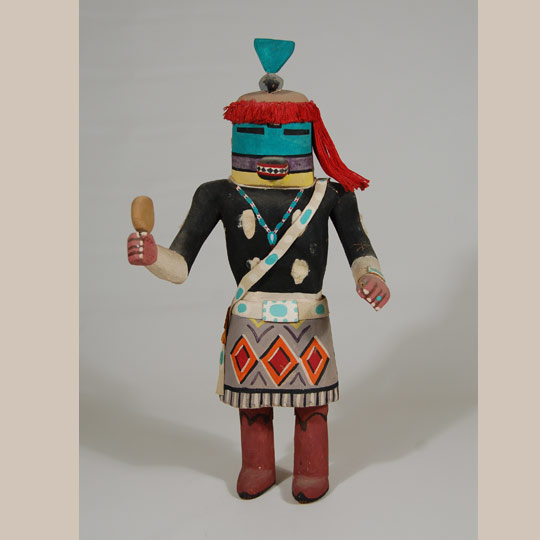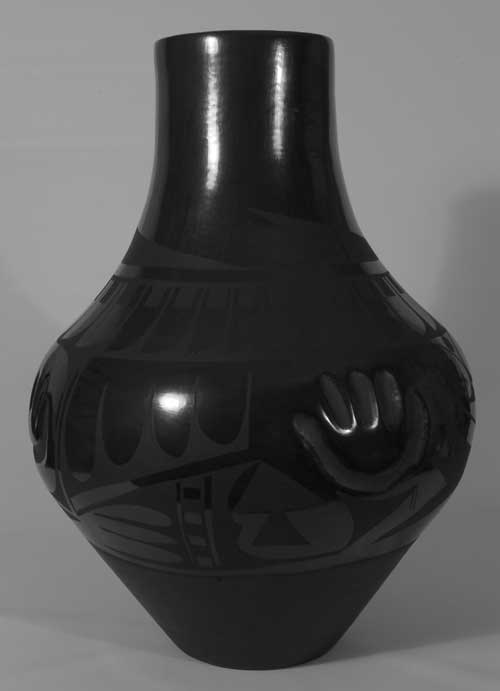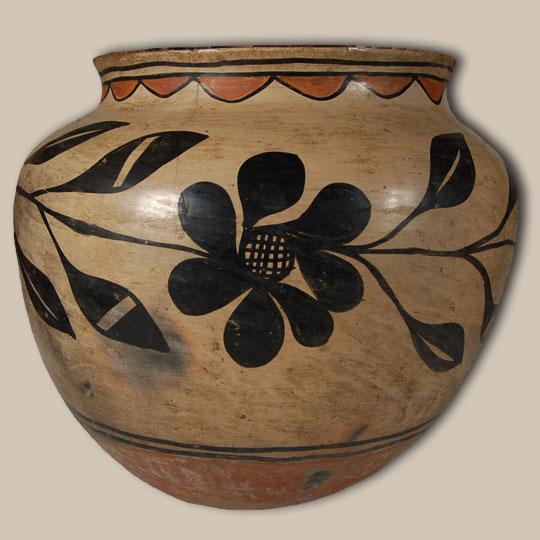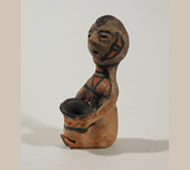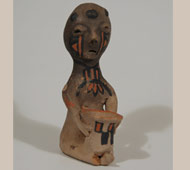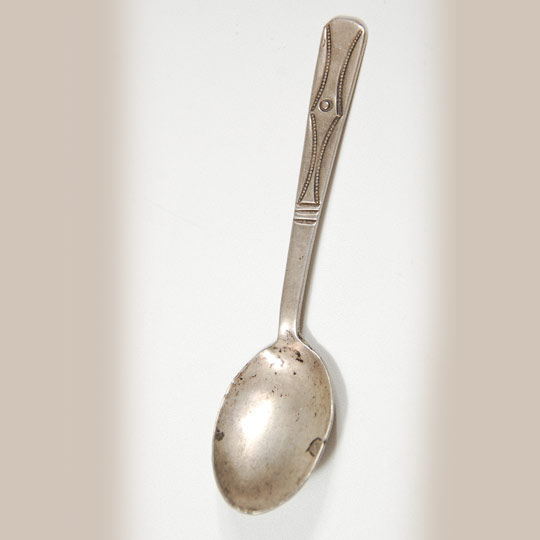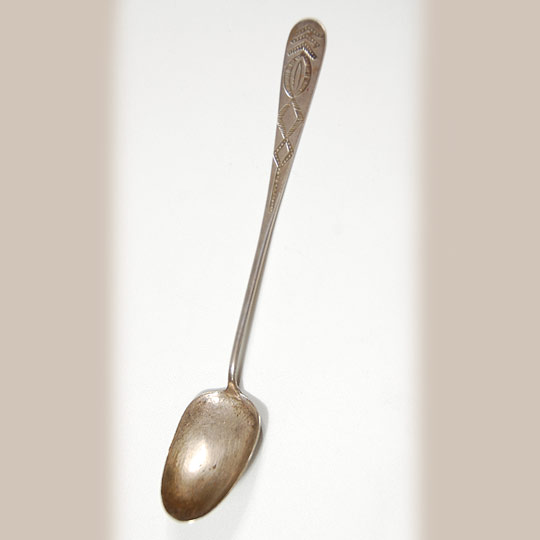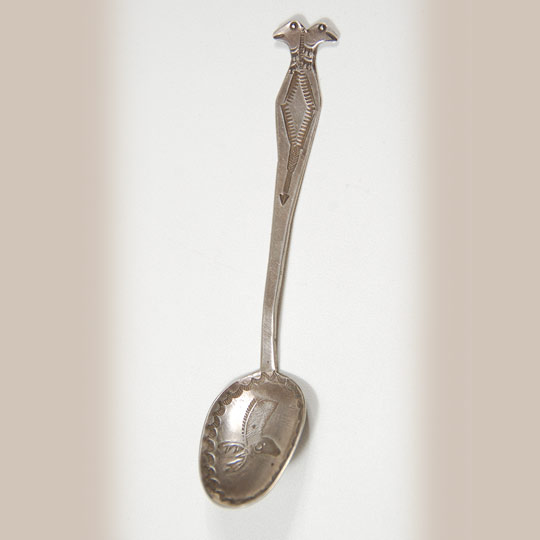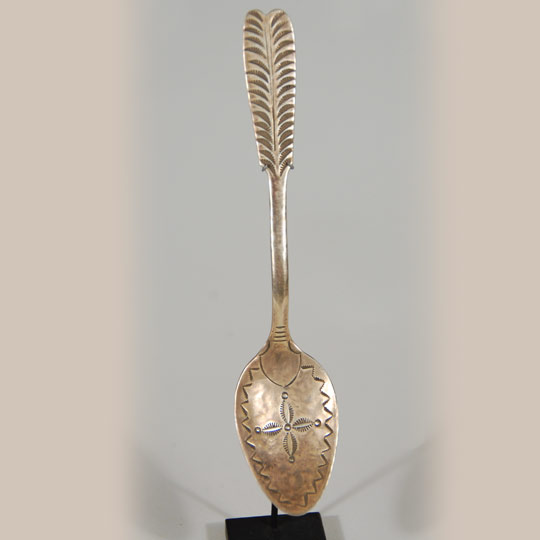Subject: Indian Archer on a Blue Horse
We just received this incredible painting by one of the most well-known and accomplished New Mexico Native artists, Tony Da. It is unlikely that any collector of the genre has not at least heard of Tony Da, son of Popovi Da and grandson to Maria and Julian Martinez.
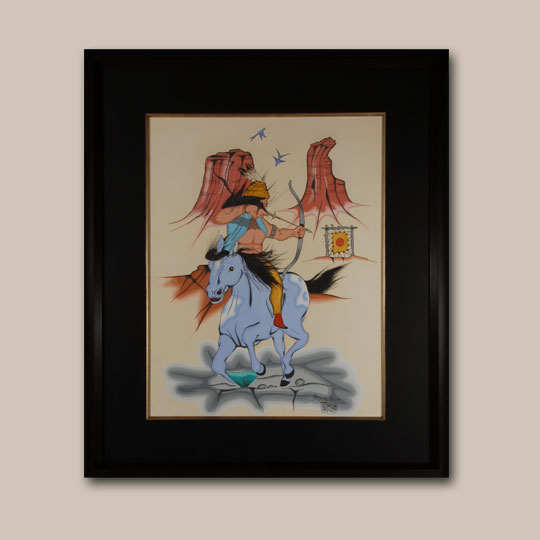
This piece features a Native American practicing the art of archery atop a muscular blue horse. The painting was completed when Tony was still in high school and proves his skill from a young age. The date on the piece is 1957, a period in the artist’s life when he was experimenting with different styles and had not yet latched onto the graphic style that he later became known for.
Underneath the signature on the painting is a cartouche or remark that resembles a jewelry design. Tony crafted jewelry in his early years, so an addition like this isn’t out of the ordinary. In fact, it is simply another testament to his talents.
The painting appears to be in very good condition with some possibly minor fading of background paper color. It is framed with archival materials and a dark brown wood frame. Learn more here.
____
Subject: Indian Archer on a Blue Horse
Artist: Tony Da
Category: Paintings
Origin: San Ildefonso Pueblo
Medium: Casein
Size: 20” x 15” image; 27-3/4” x 22-3/4” framed
Subject: Glenna Goodacre Bronze of a Young Girl Dancing
We know that Glenna Goodacre crafted this bronze likeness of a young girl dancing early on in her career, but we don’t know much more than that. There is something thrilling about seeking to gather information on such a lovely piece of work, and we have had a wonderful time trying to track down the details.
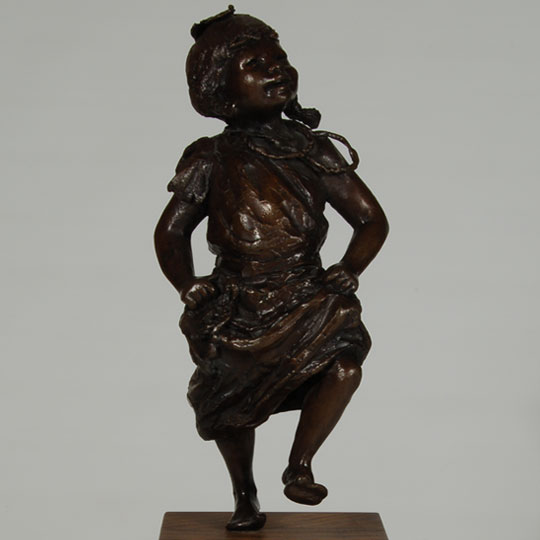
We learned that the current owners purchased the sculpture from Forrest Fenn of Fenn Galleries in Santa Fe in the late 70s. To verify, we went to Nedra Matteucci Galleries (who purchased Fenn Galleries) and we received confirmation that a couple had acquired the jovial piece in 1978.
Unfortunately, the official title, where the bronze was cast, and other pertinent information regarding the origins of the piece are eluding us, as this sculpture was not included in Goodacre’s Catalog Raisonné. While it would be lovely to have the whole background of this figure, we also find that its mystery adds to its charm. We can, however, guarantee that Goodacre did create this gem, and although we don’t know what she intended to call it, we feel that “Little Girl Dancing” suits it perfectly.
The bronze is stamped “Goodacre” and numbered 6/15. The wood base measures 3-7/8” x 3-7/8” x 5” tall.
About the Artist:
“Glenna Maxey Goodacre (born 1939 in Lubbock, Texas) is a sculptor well known for having designed the obverse of the Sacagawea dollar that entered circulation in the United States in 2000. She also designed the Vietnam Women's Memorial located in Washington, D.C., of which there is a smaller replica at Vietnam Veterans Memorial State Park in Angel Fire, New Mexico. Goodacre's art appears in public, private, municipal and museum collections throughout the U.S. Her bronze sculptures feature lively expression and texture.” [source]
____
Subject: Glenna Goodacre Bronze of a Young Girl Dancing
Sculptor: Glenna Goodacre
Category: Bronze
Origin: European-American Artists
Medium: Bronze on a Wood Base
Size: 8-3/4” tall bronze on 5” tall wood base
Special Exhibit: Katsina Imagery on Pueblo Cultural Objects [November 14, 2014 through January 31, 2015]
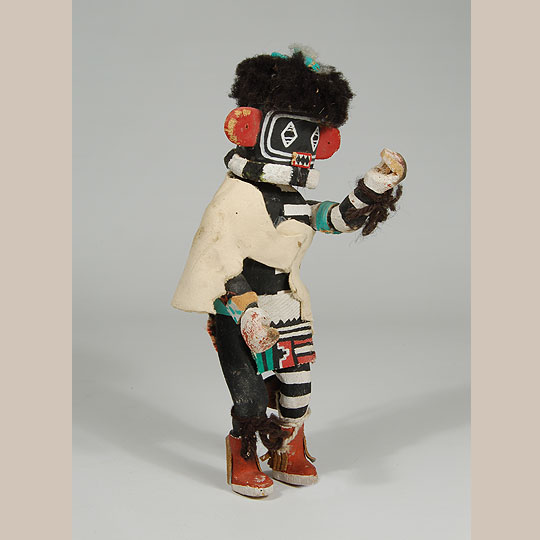 “For over 2,000 years, Native Americans of the Southwest have prayed to the great spirits to bless their world with good weather, abundant game and a bountiful harvest. The Pueblo people believe that each year, just after the winter solstice, beings known as Kachinas bring them messages from these spirits, walking upon the earth to interact with the Pueblo people. At the end of the planting season, they return to the spirit world. Since each tribe may have their own distinct Kachinas, there is thought to be over 400 of them.” [www.kachinasdolls.com]
“For over 2,000 years, Native Americans of the Southwest have prayed to the great spirits to bless their world with good weather, abundant game and a bountiful harvest. The Pueblo people believe that each year, just after the winter solstice, beings known as Kachinas bring them messages from these spirits, walking upon the earth to interact with the Pueblo people. At the end of the planting season, they return to the spirit world. Since each tribe may have their own distinct Kachinas, there is thought to be over 400 of them.” [www.kachinasdolls.com]
We are thrilled to present to you a refined exhibit highlighting katsina (kachina) imagery and various Pueblo cultural objects. We have thoughtfully displayed, both in the gallery and on our website, a comprehensive collection of Hopi and Zuni Pueblo katsina dolls – dating from the 1930s to the 1990s. Intertwined with the doll collection are bronze sculptures of katsinas by the late Hopi artist, Lowell Talashoma, paintings by early 20th century Hopi artists of katsinas, as well as paintings by later pueblo artists of katsina dance scenes. You will also see pueblo pottery adorned with katsina imagery and a lovely Hopi basket with Crow Mother and Eagle katsina imagery.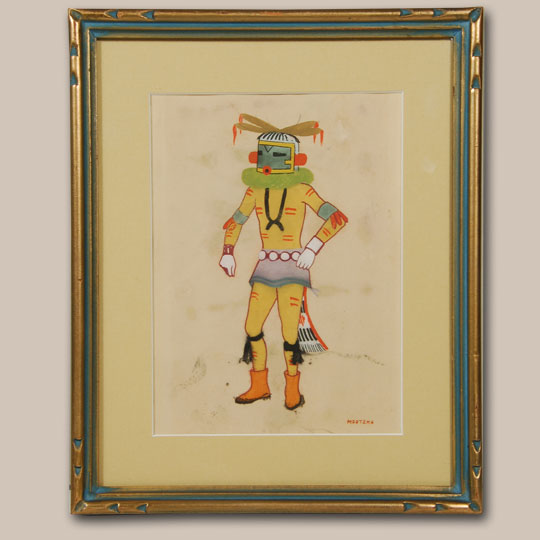
We are certain you will be captivated by the imagery, color and symbolism in this exhibit. Come by the gallery and experience the cultural and historical significance of the katsina.
____
Opening Reception Friday, November 14th 5:00 until 7:00 pm
Exhibiting through January, 2015
Subject: CULTURAL AND NATURAL AREAS OF NATIVE NORTH AMERICA (Southwest Book – Anthropology & History)
Whether you are looking to broaden your knowledge of Native North American history, or simply seeking to enhance your library with a literary treasure, take a look at one of our latest acquisitions: “CULTURAL AND NATURAL AREAS OF NATIVE NORTH AMERICA,” By A. L. Kroeber, Professor of Anthropology in the University of California.
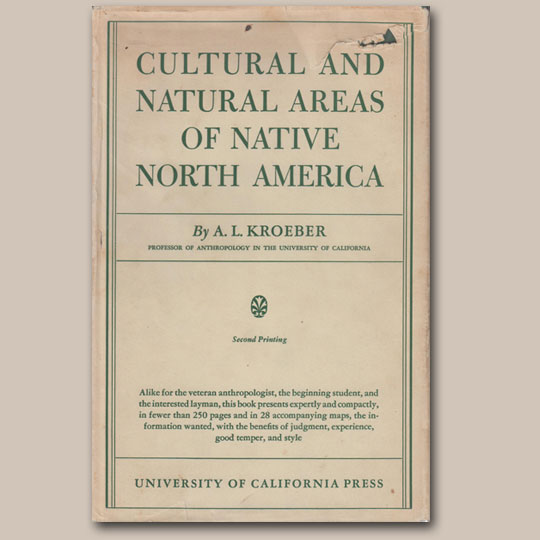
Penned and published for the first time in 1931 and published for a second time in 1947, this book was intended for “the veteran anthropologist, the beginning student, and the interested layman.” [front cover] Our copy is in very good condition, and only has some slight tears to the slip cover.
The contents include but are not limited to: Culture areas, climaxes, and boundaries; Tribal synonyms; Pronunciation of tribal names; Authorities used for vegetation maps; Sources of Eskimo culture; Ecological Phases; Many Culture Areas, ranging from the Southwest to the Intermountain Areas and beyond – even as far as Mexico and Central America; and Relations of environmental and cultural factors.
The book is out of print, so we are honored to be one of the few carriers of this informational, cultural and historical publication. Learn more about this piece of literature and even add it to your Adobe Gallery Wish List by clicking here.
____
Subject: CULTURAL AND NATURAL AREAS OF NATIVE NORTH AMERICA (Southwest Book – Anthropology & History)
Author: A. L. Kroeber, Professor of Anthropology in the University of California.
Category: Books
Date Published: December, 1939
Reprinted: 1947 (second printing)
Size: 242 pages, 28 additional maps. Illustrated.
Special Value Offer: Original Painting of Male and Female Corn Dancers
We are thrilled to say that we recently acquired this stunningly detailed J.D. Roybal painting. Roybal is known by most collectors for his Koshari clown figures, which are mostly note card size; however, he was certainly adept at painting larger-scale images such as this.
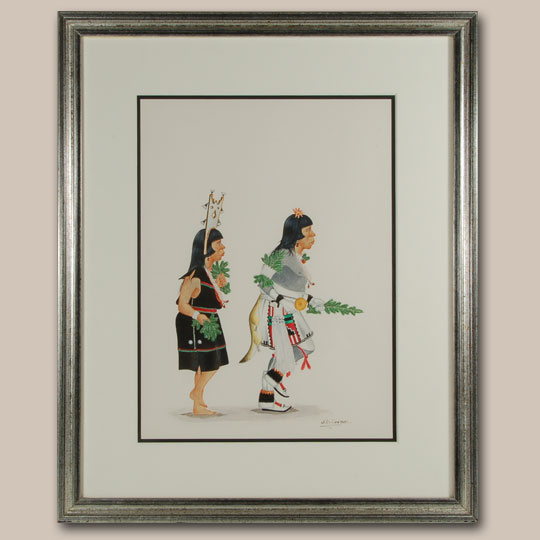
This piece is a lovely illustration of traditional male and female corn dance figures that are performing at a Harvest Dance. A close look at the intricacy of this painting is certainly recommended because the detail of their costumes is extraordinary, and their facial expressions tellingly reflect the sanctity of such a dance.
This painting was recently framed using all acid-free materials and a gorgeous silver-toned wood frame. The owner has authorized a reduction in price as well.
About the Artist:
His well-known uncle, Awa Tsireh, heavily influenced J.D. Roybal. Roybal studied at St. Catherine’s School in Santa Fe and later at the Business College of Santa Fe. He married his wife Julie in the early 1950s and soon after began producing pueblo dance designs on hand-painted Christmas cards. As early as 1955, he was seriously painting larger works and was later recognized by the Heard Museum in Phoenix and the Philbrook in Tulsa. Roybal received a consistent thread of first prizes in painting for each year since the Eight Northern Pueblos Arts and Crafts Shows began.
____________
Subject: Special Value Offer: Original Painting of Male and Female Corn Dancers
Artist: José Disiderio (J.D.) Roybal
Category: Paintings
Origin: San Ildefonso Pueblo
Medium: Watercolor
Size: 12"x9" image; 18"x15" framed
Subject: Very Large Kiua Polychrome-Cochiti Variety-Storage Jar with Amazing Bold Design
This grand Cochiti storage jar was almost certainly originally created to be an in-house storage vessel for grain, corn or other dry goods. While its purpose was for function, that didn’t stop its creator from giving it aesthetic appeal. The potter spent time crafting black paint from the leaves of the Rocky Mountain Bee plant and applied it to the rounded surface – a decorative motif that has lasted since 1880, when it was likely created.
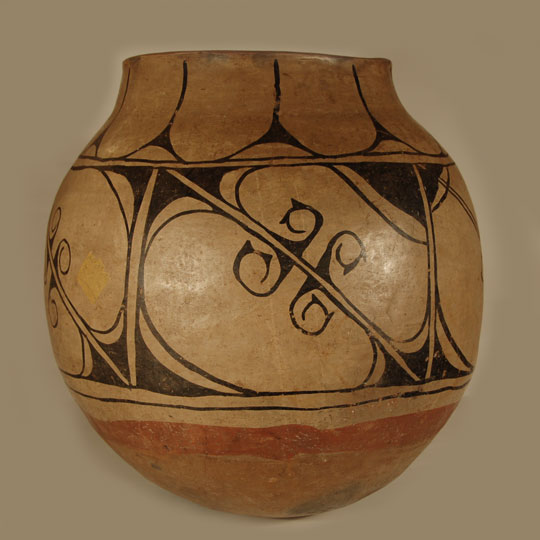
Why, one asks, does the potter feel the need to embellish such a utilitarian piece? Potters believe that a vessel is not truly complete until decorated, and it isn’t the design, but rather the act of painting the design, that brings the pottery vessel to the state of completion.
This jar was beautifully constructed and is in excellent condition. Its loose decorative style is in sync with the trends of pre-1900 vessels, and is a superb example of a traditional Cochiti Pueblo storage jar.
For additional information on this piece and to learn more about the Cochiti Pueblo, click here.
______
Subject: Very Large Kiua Polychrome-Cochiti Variety-Storage Jar with Amazing Bold Design
Potter Unknown
Category: Historic
Origin: Cochiti Pueblo
Medium: Native Clay
Size: 19-1/2 inches x 19-1/2 inches
Subject: Hopi Pueblo Navan (Velvet Shirt) Katsina Doll
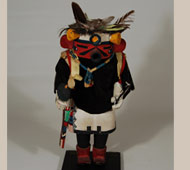 It is believed that the Navan Katsina originated at the Village of Moencopi on Third Mesa sometime after 1900. He is a very colorful Katsina with his velvet shirt and colorful ribbons. He represents the blooming of plant life and the beauty of life, as illustrated by the flowers on his head. His songs are prayers for rain to sustain life.
It is believed that the Navan Katsina originated at the Village of Moencopi on Third Mesa sometime after 1900. He is a very colorful Katsina with his velvet shirt and colorful ribbons. He represents the blooming of plant life and the beauty of life, as illustrated by the flowers on his head. His songs are prayers for rain to sustain life.
This carving was very well made. The skirt has folds and the feet turn upward slightly. The velvet shirt is adorned with ribbons and a tubular bead necklace hangs around the neck. An excellent array of feathers adorns the head. He carries a rattle in one hand and a bow in the other.
A metal stand has been provided for support but the doll may be hung from the string around its neck. It appears to be pre-1960s based.
Condition: He is in very good condition, with no evidence of damage.
Provenance: from the collection of a California gentleman
Recommended Reading: Following the Sun and Moon: Hopi Kachina Tradition by Alph H. Secakuku
Subject: Hopi Pueblo Navan (Velvet Shirt) Katsina Doll
Carver Unknown
Category: Traditional
Origin: Hopi Pueblo
Medium: Cottonwood, fabric, feathers, ribbon, beads
Size: 9-5/8” tall
Special Exhibit: Hopi and Zuni Pueblos Katsina dolls from the estate of Tom Mittler
INTRODUCTION
The clowns have been called the Delight Makers and indeed that is one of their purposes. They make the Hopi and the New Mexico pueblo people laugh, sometimes at mockery of themselves and other times at mockery of non-Indians. They are not Katsinas but do accompany the Katsinas during dances. Most New Mexico pueblos ask non-pueblo people to depart before the arrival of the clowns. They see it as a special occasion for them alone.
At Hopi, all the villages permit non-Indians to witness the antics of the clowns. When it appears that the clowns are acting up in a humorous manner, they actually are doing so with a purpose. It is their intent to teach the Hopi to maintain their cultural cohesion and preserve their status quo. In their antics, they are actually illustrating to the Hopi acts that are not acceptable, such as gluttony and deviant behavior. What the clowns act out is what it is to be non-Hopi. Sometimes this can be quite humorous. It is their responsibility to be the keeper of tradition.
The Hopi have four groups of clowns: the Tsukuwimkya, the Paiyakyamu or Koosa, the Koyemsi, and the Piptuyakyamu. The first and last are native to the Hopi and the other two have been borrowed from the New Mexico pueblos. The most famous is the Koosa, known as the Koshari, and referred to as the Hano Clown, after the name of the Tewa Village, Hano, at First Mesa, because that is where this clown first appeared with the arrival of the Tewa Indians in the early 18th century.
The dress of the Koshari is strictly enforced. The horns are of sheepskin stuffed with grass and the tips are tasseled with crinkled cornhusk strips. They are painted with charcoal and kaolin. The body is painted black with corn smut, but soot can also be used. Kaolin provides the white stripes. They wear old and worn moccasins, frazzled breechclouts, and worn blankets wrapped around their hips. A pouch of cornmeal hangs around their necks.
The Koshari appear only during the spring and summer dances and then only in the afternoon. Their official entrance to the plaza is always over the roof tops, to represent their coming over the clouds to the Hopi mesas. They pop up at the edge of a roof and announce their presence with a loud whoop and much ruckus. From then, they began their show.
Excerpted from Clowns of the Hopi: Tradition Keepers and Delight Makers by Barton Wright.
THE EXHIBIT (click here to view now)
Subject: Hopi Older Unsigned Tasap Katsina Doll
The Hopi have katsinam that honor and depict other tribes that are their neighbors, among them, the Navajo (Diné). This male version of Tasavkatsinam (Tasaf, Tasap) is in honor of their near neighboring tribe, the Diné. Katsina of this style are not borrowed from other tribes but are in honor of the other tribes. They are Hopi Katsina in all respects and are accorded the same reverence and honor as any other katsina. Their function, as is the function of all Hopi katsina, is to serve the Hopi as messengers to the rain gods.
This carving by an unknown Hopi carver probably dates to circa 1950s. He features an elegant arrangement of red hair made from fine red yarn. The bandoleer across his chest is made from deer hide as is the concha belt and the ketoh on his left wrist.
Condition: He had cotton glued to the four white spots on his chest and back and the white spot on each of his arms but most of the cotton is missing. He carries a gourd rattle in his right hand but whatever he might have had in his left hand is missing as are the feathers on the right side of the mask. There is a faint crack in the paint behind the right shoulder but it is not significant.
Provenance: from the estate of Michael Frost of Texas
Recommended Reading: Kachinas: a Hopi Artist's Documentary by Barton Wright
Subject: Hopi Soyokomana Katsina Doll
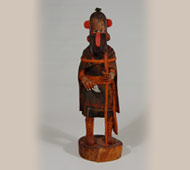 Soyokomana Katsina is the Ogre Woman. She appears during the Powamu ceremony, accompanied by the ogre, Nataska. She approaches households begging for food to take back to the kivas for the Katsinas to eat. If she is given too little or something not to her pleasure, she growls in disapproval. She has a basket on her back in which she carries off the acceptable food.
Soyokomana Katsina is the Ogre Woman. She appears during the Powamu ceremony, accompanied by the ogre, Nataska. She approaches households begging for food to take back to the kivas for the Katsinas to eat. If she is given too little or something not to her pleasure, she growls in disapproval. She has a basket on her back in which she carries off the acceptable food.
The Nataska, usually in pairs, accompany the Soyokomana and stand behind her as she bargains with the children. They make horrible noises to frighten the children and supposedly they are able to eat a child whole. The Soyokomana accepts food in lieu of hauling off children who have not lived up to the Hopi ways. By doing this, the mother, who has bargained with her to accept food, rather than her children, comes out to be the best and the winner.
Henry Fred has illustrated the Soyokomana in her traditional manner, carrying a knife to scare the children and a staff to grab them by the neck, which, of course she does not do but only threatens to do.
Condition: the carving was purchased from the Heard Museum in Phoenix, AZ in 1990 and is presumed to have been recently made. It is in original condition.
Provenance: from the estate of Michael Frost of Texas
Recommended Reading: Hopi Katsina, 1,600 Artist Biographies by Gregory Schaaf
Subject: Hopi Soyokomana Katsina Doll
Artist / Carver: Henry Fred (1951 - present)
Category: Contemporary
Origin: Hopi Pueblo
Medium: Cottonwood root, oil-based stains
Size: 12-1/2 inches tall
Item # C3360Q
Subject: Hopi Pueblo Mudhead (Koyemsi) Katsina Doll
The Mudhead has been named such because the mask and body of the participant is covered in reddish mud. According to Barton Wright, this Hopi personage has been called Koyemsi but that term is from the Zuni Pueblo and means "husband" as in animal husbandry, one who cares for a flock. He states that neither Mudhead nor Koyemsi is the correct name for this Hopi Katsina. He states that the proper Hopi name is Tachukti, a term which means "ball on head." It is not likely that the name Mudhead or Koyemsi will disappear because those are names generally known for this personage.
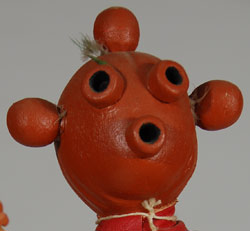
Because of the looks of the head covering, with its numerous knots, the Mudhead is generally considered to be a clown; however, it is not the case. He serves a multitude of purposes. Even though he is amusing and performs hilarious antics, he is far more than a clown. He may be a curer, a magician, a dance director, a warrior, a messenger, a sage or, even a fool.
In this carving, Silas Roy has presented the Mudhead Katsina as a drummer. It is an earlier carving from 1976, a time when acrylic paints were still the vogue and before many carvers progressed to one-piece carvings and the use of oil based stains in lieu of paint. The carving is quite exceptional for the period.
Condition: appear to be in original condition with the loss of some feathers on the head.
Provenance: originally purchased in 1976 from the Museum of Northern Arizona in 1976, currently from the estate of Michael Frost of Texas.
Recommended Reading: Clowns of the Hopi: Tradition Keepers and Delight Makers by Barton Wright
Subject: Hopi Pueblo Mudhead (Koyemsi) Katsina Doll
Artist / Carver: Silas Roy, Sr. (1948-present)
Category: Contemporary
Origin: Hopi Pueblo
Medium: Cottonwood root, acrylic paints
Size: 16-3/4 inches tall
Item # C3360V
Subject: Casas Grandes Utilitarian Two-handle Jar
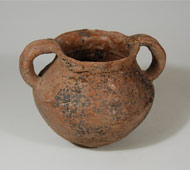 Casas Grandes pottery was first produced about 1000 years ago in an area of Northern Mexico called Paquimé. At first the pots were strictly utilitarian vessels. Eventually, their style, shape and quality transformed through trade with the Hohokam and Anasazi.
Casas Grandes pottery was first produced about 1000 years ago in an area of Northern Mexico called Paquimé. At first the pots were strictly utilitarian vessels. Eventually, their style, shape and quality transformed through trade with the Hohokam and Anasazi.
The shape of this small jar is very traditional to Casas Grandes utilitarian wares. The bottom is round and the body is globular with a constricted neck and flaring rim. Two handles connect the rim with the shoulder of the jar.
The jar was formed from coils of clay which were pinched together and then smoothed out with a gourd or other scraping tool. The clay was stone polished without the addition of slip.
Condition: structurally very good condition with some minor rim chips.
Provenance: from the collection of Katherine H. Rust
Recommended Reading: Secrets of Casas Grandes, edited by Melissa S. Powell
Subject: Casas Grandes Utilitarian Two-handle Jar
Potter Unknown
Category: Pre-Columbian or Prehistoric
Origin: Mexico
Medium: clay
Size: 5-1/2" tall x 6-3/4" wide
Item # C3309M
Subject: Large Black-on-Black Bear Paw Jar
Carmelita Dunlap was the daughter of Juanita Vigil and Romando Vigil. Carmelita’s mother passed away when Carmelita was only 8 years old. Her mother’s sisters, Maria Martinez and Desideria, raised her. Carmelita would stay with Maria for three months or so then stay with Desideria three months or so. She learned pottery making from watching the two distinguished potters at work.
Carmelita was one of the pueblo potters invited to visit the White House in 1974 at the request of President and Mrs. Nixon.
Carmelita always preferred making large pieces of pottery. This one, however, is the largest I have ever seen. She decorated it in the traditional black-on-black technique but added an element to the design that I have never known a San Ildefonso potter to do—that is impressing bear paws into the clay as is done at Santa Clara Pueblo. I think this is truly a unique pottery jar by a unique potter.
COMMENTS: Some experts have contended that smothering pottery during the firing process creates a carbon smoke that penetrates the pottery, turning it black. Even though several books describing black pueblo pottery attribute the color change to carbon, the reduction of iron oxide is the correct mechanism. Ceramicists, describing ancient styles of Old World pottery, state that iron impurities in clay form red oxide at red heat, but if air is lacking during firing, iron impurities in clay form black magnetite.
Provenance:This Large Black-on-black Bear Paw Jar was part of the exhibit Art Treasures of New Mexico show July 23, 2005 until August 20, 2005 presented at adobe gallery Santa fe.
Subject: Large Black-on-Black Bear Paw Jar
Artist / Potter: Carmelita Dunlap (1925-1999)
Category: Contemporary
Origin: San Ildefonso Pueblo
Medium: Native Materials
Size: 17-1/2" tall x 13" diameter
Item # 24385
Subject: Very Large Acoma Pueblo Fine-line Storage Jar
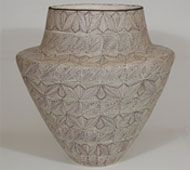 Virgie Garcia is believed to be a contemporary active potter although I can find no definite evidence of that. She is listed in Dillingham as an active potter in 1991 and Schaaf acknowledges her in his book in 2002. She credits her grandmother, Lolita Garcia, with teaching her the techniques of pottery production.
Virgie Garcia is believed to be a contemporary active potter although I can find no definite evidence of that. She is listed in Dillingham as an active potter in 1991 and Schaaf acknowledges her in his book in 2002. She credits her grandmother, Lolita Garcia, with teaching her the techniques of pottery production.
This large storage jar is certainly testimony to her talents as a potter and painter of pottery. This is an extremely large jar for one to even consider painting with intricate fine-line designs. The entire surface is covered in fine-line technique. There are 10 horizontal bands of fine-line design. Every alternating band changes design. The individual design elements expand in size as the dimension of the jar expands.
This is an exception visual presentation and a masterful application of a favored Acoma design.
Condition: original condition with very minor spalling that is almost non-existent.
Provenance: from a gentleman in Albuquerque
Recommended Reading: Southern Pueblo Pottery 2,000 Artist Biographies by Gregory Schaaf
Subject: Very Large Acoma Pueblo Fine-line Storage Jar
Artist / Potter: Virgie Garcia (1947-present)
Category: Contemporary
Origin: Acoma Pueblo
Medium: native clay, pigment
Size: 15-1/2" tall x 15-1/4" diameter
Item # C3302B
Subject: Kewa Pueblo Polychrome Storage Jar
This storage jar was formed of native clay with typical crystalline rock temper. The underbody was not slipped but the natural tan clay of the vessel was stone-polished to a hard finish and the Kewa Pueblo distinctive large red band of rough polish, striated, soapy-like appearance was added below the design band. This is indicative of a post-1880 date.
The bottom of the vessel is flat as is traditional with storage jars, unlike water jars that have a concave underbody. The neck interior was slipped first in bentonite slip then red slip was rag-wiped over the bentonite leaving a quarter-inch of bentonite visible. The rim top is black (a post-1800 characteristic). There is significant evidence of use. The rag-wiped bentonite slip is a wonderfully warm cream/off-white color, with subtle fire clouding and superb patina.
The entire body was designated for the design panel without a division separating the neck area from the body. The large floral vegetal black design is typically Kewa Pueblo in origin with certain boldness and seemingly deliberate execution—a sure mark and fantastic sense of space and design. A series of semicircular elements, suggestive of clouds, are suspended from one of the two framing lines around the neck. A second pair of framing lines encircles the vessel body at the base of the design. All four framing lines feature ceremonial breaks.
This is a fantastic example of a Kewa Pueblo Polychrome jar with excellent patina, a warm/subtle glow to the white slip, and beautifully executed vegetal-black design elements.
Condition: There were several insignificant line cracks which have been repaired and an area of exfoliation due to water overflow that has been left in the natural state with no attempt to over-paint. This is a true find for the collector of the finest quality historic pueblo pottery from circa 1890-1910.
Provenance: from the collection of a Phoenix ranching family.
Recommended Reading: A River Apart: The Pottery of Cochiti and Santo Domingo Pueblos by Valerie K Verzuh
Subject: Tesuque Pueblo Turn of the Century Rain God Clay Figurine
This is one of the most beautifully decorated Rain God figurines of the period. The rust red and black designs on the cheeks, the elaborate necklace and the designs on the pottery are all exquisitely executed. The darkness of the figurine contrasts beautifully with the brightness of the painted designs.
This figurine is typical of the style made in the early 1900s. The figurine was covered in cream slip over which the elaborate design was painted in black and red vegetal and mineral paints. The figurine has sculpted hair painted black and holds a decorated jar on his lap. The painted designs are typical of the early 1900s figurines. This is one of the more elaborately painted rain gods which makes one suspect it is one of the earlier ones before demand increased so significantly that potters began producing faster and decorating less.
This figurine and our Item #25621 certainly were made at the same time and by the same potter. Here is a link to the other Rain God:
Tesuque Pueblo Polychrome Rain God Figurine (click here to view it now)
What a great pair they make sitting side-by-side!
Condition: one foot is missing and there is an abrasion on the right shoulder.
Provenance: from a gentleman in Taos, NM whose grandfather owned a curio store near the plaza.
Reference and Recommended Reading: The Native American Curio Trade in New Mexico by Jonathan Batkin
Subject: Tesuque Pueblo Turn of the Century Rain God Clay Figurine
Potter Unknown
Category: Figurines
Origin: Tesuque Pueblo
Medium: clay, pigment
Size: 6-3/4" tall
Item # 25622
Subject: Coin Silver Navajo Spoon with Stamped Handle
Navajo silver spoons were hand forged from Mexican silver coins or American silver coins. Mexican coins were favored because the silver content was higher than comparable American coins. The coins were hammered into thin sheets and then shaped into the desired form for a spoon. Once the hammering and forging were complete, the spoon was then stamped with the desired designs.
This spoon appears to be from coin silver as it is heavier and thicker than most.
Condition: it appears that a crack in the bowl was repaired.
Provenance: private collection of a Virginia family
Recommended Reading; Navajo Spoons: Indian Artistry and the Souvenir Trade, 1880s - 1940s by Cindra Kline
Subject: Coin Silver Navajo Spoon with Stamped Handle
Unknown Maker
Category: Silverware
Origin: Diné - Navajo Nation
Medium: coin silver
Size: 4-1/2" long
Item # C3393F
Subject: Silver Navajo Spoon with Stamped Handle
Navajo silver spoons were hand forged from Mexican silver coins or American silver coins. Mexican coins were favored because the silver content was higher than comparable American coins. The coins were hammered into thin sheets and then shaped into the desired form for a spoon. Once the hammering and forging were complete, the spoon was then stamped with the desired designs.
This spoon has a long and graceful handle, extremely thin at the bowl and gradually widening at the other end on which a series of stamps were used to decorate it to the maker's delight.
Condition: original condition
Provenance: Rainbow Man, Santa Fe
private collection of a Virginia family
Recommended Reading; Navajo Spoons: Indian Artistry and the Souvenir Trade, 1880s - 1940s by Cindra Kline
Subject: Silver Navajo Spoon with Stamped Handle
Unknown Maker
Category: Silverware
Origin: Diné - Navajo Nation
Medium: silver
Size: 6-1/8" long
Item # C3393E
Subject: Silver Navajo Spoon with Double Headed Bird on Handle
Indian traders were significant influences on Native artists in determining what the artists were to make. It was the traders who knew what they could sell so they instructed the artists to make those items. In addition to traders, government-sponsored Indian schools were an influence as well.
Carlisle Indian School in Carlisle, Pennsylvania, founded in 1879, was the first federally run Indian boarding school. One of its functions was to teach the students a trade, and one of the trades was silversmithing. A 1910 brochure from Carlisle promoted "Navajo silver items produced at the school, hand-hammered out of Mexican silver dollars."
This silver spoon features a double-headed bird at the handle's end and a deer's head in the bowl. The hand file marks are quite visible on the back of the handle. This spoon dates to circa 1910-1915.
Condition: original condition
Provenance: Alan Kessler Gallery, Santa Fe
private collection of a Virginia family
Recommended Reading; Navajo Spoons: Indian Artistry and the Souvenir Trade, 1880s - 1940s by Cindra Kline
Subject: Silver Navajo Spoon with Double Headed Bird on Handle
Unknown Maker
Category: Silverware
Origin: Diné - Navajo Nation
Medium: sterling silver
Size: 4-1/8" long
Item # C3393D
Subject: Silver Navajo Spoon with Feather-design Handle
This elaborately decorated silver spoon features a feather-pattern handle and a stamped bowl of elaborate symbols. It dates to circa 1900. Spoons such as this appeared in pamphlets and catalogs of Navajo traders as early as 1902 and possibly earlier. Traders such as Lorenzo Hubbell, C. N. Cotton, and J. B. Moore featured them. Moore advertised them at $1.50 per oz.
The fascination with Navajo-made silver spoons waned around 1915. Navajo smiths switched from making souvenir spoons to making, on special order, complete table service silver.
This spoon comes with a specially-made display stand that permits the spoon to be displayed in a frontal view.
Condition: original condition
Provenance: Medicine Man Gallery, Santa Fe
private Virginia family collection
Recommended Reading; Navajo Spoons: Indian Artistry and the Souvenir Trade, 1880s - 1940s by Cindra Kline
Subject: Silver Navajo Spoon with Feather-design Handle
Unknown Maker
Category: Silverware
Origin: Diné - Navajo Nation
Medium: silver
Size: 6-1/8" long
Item # C3393C


